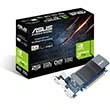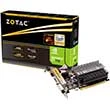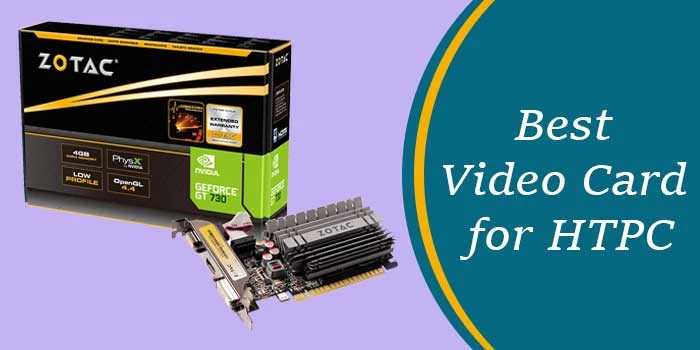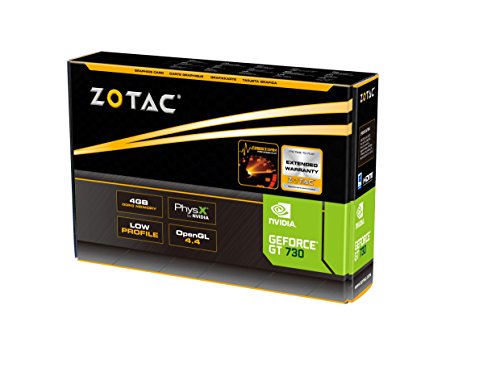by Malcolm Woods
You come home after a long day at work. All you can think about during work is the new show you started watching on Netflix. Hey, we're not judging you here. Some of the shows are really addictive and entertaining.
But right as you're about to relax and put the show on, you notice the picture quality is just not cutting it.
What do you do? Are you bound to blurry images? No, you're not. Why not pick up the best video card for HTPC then?
You can easily upgrade your PC's graphics capabilities and enjoy a crisper and sharper image. Need to get your hands on the perfect video card? We'll help you through.
Contents
Follow This Table For Quickly Select A Product
| Product Image | Name | Editor's Rating | Price |
 | Asus GeForce GT 710 2 GB | 4.5 / 5.0 | Price Check |
 | ZOTAC GeForce GT 730 4GB | 4.7 / 5.0 | Price Check |
 | Asus GeForce GT 1030 2GB | 4.8 / 5.0 | Price Check |
Before we dive into the review, let's get into the benefits of getting a video card for your HTPC. Are they even worth it? The answer will depend on who you ask. But we firmly believe that it is most definitely worth it.
A good HTPC video card will perform leaps and bounds better than the integrated graphics that are already in your processor. You get hardware video acceleration with a video card.
You can let the video card alone deal with decoding high-resolution video. This takes off some load from the CPU. Apart from that, the general use case will also improve.
Also, you can watch movies in high resolution without pegging the CPU at 100%. You get a crisp and sharp image throughout the display panel.
Especially if you have an aging CPU, it might get difficult for it to push the graphics. A dedicated video card will help a lot in this case. Of course, there is also the option to do some gaming as well.
Generally, HTPCs aren't used for much gaming, but it sure is nice to have that option. A computer that can be used for gaming will also handle any multimedia tasks you throw at it like a champ.
Choosing a video card from all the options available can be a daunting task. Especially when you're not technically adept. Here is a complete in-depth review of the three video cards that fit perfectly for an HTPC build.


If you're familiar with PC hardware, Asus requires no introduction. They're a goliath in the field and have garnered quite the name for themselves. Their ROG line of products is quite special.
This video card from the manufacturer also gets the same amount of love and high-quality engineering as its bigger brothers. However, you need to manage some expectations here.
The video card is made for gaming as much as a Toyota Prius is made for racing. Which is to say, it isn't made for gaming. While you can play games on it, it'll not be a good experience. As a video card for HTPC, though, this is a champ when it comes to video card value.
It has a 2GB memory buffer. And it's a fast memory too. The GDDR5 memory is clocked at an effective 5012 Mhz. The core clock is 954 MHz with 192 CUDA cores.
The specs are modest and deliver just enough power to give you a smooth day-to-day and multimedia experience. On top of all that, you get that legendary Asus reliability.
One of the best things about HTPC video cards is they are very power efficient. You don't need a power supply to run them. That is also true for this model. If your HTPC does not have a dedicated video card and you want to upgrade it for cheap, this one works great.
Highlighted Features


Zotac is another brand that has become popular recently for its high-quality products. We love Zotac's design. But as most of you know, the design is only one part of a tech product.
Take our previous products, double the CUDA cores plus the memory, and you'll have the GeForce GT 730 4GB. This card will perform better compared to our previous one. After all, 730 is higher than 710, isn't it?
Terrible jokes aside, if you're looking for more power compared to integrated graphics, this will fit in perfectly. You also get modern features like 4K resolution support, Anti-Aliasing, and the whole shebang.
There is one caveat, though. Even though the memory is 4GB, it is a slower DDR3 memory. Having said that, the video card performs better than the GT710 across the board.
We will dive into video memory more a bit later in the article. So, keep on reading. It might save you from making one of the most common mistakes when shopping for a video card.
You can also do some light gaming with it. E-sports titles like Counter-Strike and League of Legends will run just fine. Expect to get over 30 FPS on Counter-Strike. But then again, gaming is really not its strong suit.
Video streaming and high-definition video watching will be a breeze with this one.
Highlighted Features


Still looking for the best HTPC video card from Asus? With this GT 1030, you can also get into a bit more serious gaming if you want.
Right off the bat, you'll notice the memory on this is one is lower than the GT 730. It comes at 2GB, just like our first product.
All memory isn't made the same. Even though the memory on this video card is lower, it's more powerful than all the other cards on the list. In fact, this is the perfect 4K video card for HTPC. It has more CUDA cores at 384, and the memory clock is still a respectable 6008 Mhz.
What makes this card perform so well as an HTPC video card is the core clock speed. The core boost clock speed is 1506 MHz, and the base speed is 1266 MHz. This will not only allow you to watch high-resolution videos but will also help you play more modern high demanding games.
We have to do our due diligence here. Do not expect record-breaking frame rates when gaming, though. It will most definitely perform better compared to other video cards on the list, but it isn't made for gaming.
What this card provides you are options. Along with stellar multimedia capabilities, you can also dabble into some gaming. Think about it this way, after you've exhausted Netflix's library, what do you do now?
How about some multiplayer gaming with some friends? This video card hits that perfect balance and is one of the fastest video cards for any HTPC.
Highlighted Features

Making the wrong decision when buying a video card can put a sour taste in your mouth. We know you want the best video card for HTPC. But, if you would like a little more information on choosing the right one, we got you covered. Here are the factors to consider.
When buying any PC hardware, regardless if it's a video card for an HTPC or a processor for a workstation, always think about your use case. What are you planning to do with it?
If you have that figured out, you can reverse engineer your purchase. You already know what your needs are, and this way, you won't spend extra on things you don't need.
Now, if you plan to only watch high-resolution videos and movies with no plans on gaming, you don't need much power. Get a low-end card and call it a day. If you plan to do some light gaming, though, it is always better to spend a little bit more for extra power that you can use down the line.
If you're upgrading your HTPC with a video card, the chances are that it's using the integrated graphics. Integrated graphics are built-in with the processor. When you add a video card into the mix, you'll have a dedicated GPU.
Beefy GPUs or video cards will need extra power. That might require you to buy an external power supply. If you're already budget constraint, you might not have the extra cash for a power supply.
Video cards for HTPCs are not that demanding. They don't require much power and should be able to run without a power supply. The power can be drawn right from the PCIe slot.
This will also make them low-profile units and should fit in most cases. Make sure to check if the video card you're getting needs an extra power supply or not. Also, it goes without saying more powerful video cards will require a power supply.
This is where most people make a mistake. Just because a card may have higher memory than the other doesn't mean it'll perform better. A 2GB card might perform better than a 4GB card if the core clock of the GPU is higher.
Large memory buffers are helpful in high-resolution gaming. Since you're buying a video card for HTPCs and probably will not game as much, you can go for 2GB or 4GB. Again, the clock speed matters as well.
As a general rule of thumb, the model number of the card itself is a good indicator of its performance. Our GT 1030 comes at 2GB, but the GT730 comes at 4Gb. The GT 1030 is more powerful than the GT730, though.
Lastly, we have to consider the brand reputation. When choosing a graphics card brand, we would recommend picking any of the reputed ones, and you should be just fine. These companies have years of experience in the field.
All of the top tier brands like Asus, Zotac, and others like Gigabyte are top choices for video cards. Pick the card that suits your needs from any of these brands, and you shouldn't face any problems.
Related Accessories: Best Quality Static Pressure Fans
In today's modern times, video cards and graphics cards are the same things. They are simply expansion cards that allow a computer to have more graphics prowess. All of them will have a processing unit called the GPU. This is very much like a CPU, but it deals with all the visuals.
This card's purpose is to display an image onto the monitor. Other functions include determining the resolution of the image you see on the screen and also the number of bits used for the color reproduction on the image.
They're much like a motherboard. They have a PCB, which stands for Printed Circuit Board. They also have RAM but also specifically referred to as video RAM or video memory.
There is a processor in the card itself, as we mentioned before, which is referred to as a GPU. All the components together, the GPU, PCB, power connectors, video RAM, make a video card or a graphics card.
Of course, it also has other components like a BIOS and connectors to hook up monitors to the card. You'll find different connectors on these cards. The most common ones are DVI, HDMI, and also DisplayPort. DisplayPort is found on newer ones.
These connectors are used to hook up the monitor for displaying an image. In some computers, the video and graphics aspects of computing can be taken care of by the processor.
And when we say the processor, we don't mean the GPU, we mean the CPU. The central processor unit that you'll have on the motherboard. Most Intel processors have integrated graphics as so dome AMD ones.
So, you can run your PC just fine with it. When using integrated graphics, you would hook up the monitor to the video connectors of the motherboard. As soon as you install a video card or a graphics card in the system, you have a dedicated video card.
All the graphics load is taken off the CPU. The video card will handle everything that has to do with graphics from this point. That includes decoding video, displaying the operating system, and if you play games, that too.
With a dedicated video card installed, you'll hook up the monitor to the connector on the back of the video card. The card will sit in a slot on X58 motherboard. This slot is called PCIe or PCI express.
Previously, video cards were not as capable. They used to only convert a digital signal to an analog, and the monitor converted that to images and texts. Modern video cards (or graphics cards) are much more complex with their own processors, BIOS, and memory.
You definitely should. A dedicated video card will be great for adding more graphics performance to your HTPC. Just make sure to know your use case, so you don't overspend.
Video cards are all PCIe compatible. Your motherboard will have a PCIe slot, and all PCIe cards will be compatible with any motherboard.
All video memory is not made the same. What matters more is the core clock speed of the GPU itself. 2GB to 4GB video memory should be fine, but also pick the one which has a faster GPU.
Yes, you can! Both PCIe 3.0 and PCIe 4.0 are backward and forward compatible.
Low profile HTPC video cards generally do not require a power supply. The power from the PCIe slot is sufficient. Beefy cards for serious gaming require a power supply.
Hopefully, this has helped you narrow down your choice for the best video card for HTPC that works for you. All the cards mentioned here are from reputed brands and will work joyfully with any HTPC with a PCIe slot. Pick the one that fits your budget and get the popcorn ready.
ASUS ROG STRIX NVIDIA GeForce RTX 3080 OC Edition Gaming Graphics Card (PCIe 4.0, 10GB - Walmart, Etsy, Ebay
EVGA 10G-P5-3885-KR GeForce RTX 3080 XC3 ULTRA GAMING, 10GB GDDR6X, iCX3 Cooling, ARGB - Walmart, Etsy, eBay
MSI Gaming GeForce RTX 3080 10GB GDRR6X 320-Bit HDMI/DP Nvlink Torx Fan 3 Ampere - Walmart, Etsy, eBay
EVGA GeForce RTX 3080 Ti FTW3 Ultra Gaming, 12G-P5-3967-KR, 12GB GDDR6X, iCX3 Technology, - Walmart, Etsy, eBay
GIGABYTE GeForce RTX 3080 Ti Gaming OC 12G NVIDIA 12GB GDDR6X Graphics Card - Walmart, Etsy, eBay
Gigabyte GeForce RTX 3090 EAGLE OC 24G Graphics Card, 3x WINDFORCE Fans, 24GB 384-bit - Walmart, Etsy, eBay
Gigabyte GeForce RTX 3090 GAMING OC 24G Graphics Card, 3x WINDFORCE Fans, 24GB 384-Bit - Walmart, Etsy, eBay
GIGABYTE GeForce RTX 3090 Vision OC 24G Graphics Card, 3X WINDFORCE Fans, 24GB 384-bit - Walmart, Etsy, Ebay
XFX Speedster QICK308 Radeon RX 6600 XT Black Gaming Graphics Card with 8GB GDDR6 HDMI - Walmart, Etsy, eBay
PowerColor Red Devil AMD Radeon RX 6600 XT Gaming Graphics Card with 8GB GDDR6 Memory, - Walmart, Etsy, eBay
XFX Speedster QICK319 AMD Radeon RX 6700 XT Ultra Gaming Graphics Card with 12GB GDDR6 - Walmart, Etsy, eBay
Sapphire Pulse Radeon RX 6800 OC 16G, 16384 MB GDDR6 - Walmart, Etsy, Ebay
Sapphire 11304-03-20G Pulse AMD Radeon RX 6800 XT PCIe 4.0 Gaming Graphics Card with 16GB - Walmart, Etsy, Ebay
MSI Gaming GeForce RTX 3090 24GB GDRR6X 384-Bit HDMI/DP Nvlink Tri-Frozr 2 Ampere - Walmart, Etsy, eBay
MSI NVIDIA GeForce RTX 3090 Gaming X Trio 24GB GDDR6X Graphics Card - Walmart, Etsy, eBay
MSI GeForce RTX 3090 DirectX 12 Ultimate RTX 3090 Gaming Trio 24G 24GB 384-Bit GDDR6X PCI - Walmart, Etsy, Ebay
PNY GeForce GTX 1660 Ti 6GB XLR8 Gaming Overclocked Edition GDDR6 Graphics Card - Walmart, Etsy, eBay
 |
 |
 |
 |

About Malcolm Woods
Malcolm Woods is a blogger who enjoys writing about technology and solar power. He has a passion for learning new things, and loves to share his knowledge with others. Malcolm is also an advocate for sustainable living, and believes that everyone has a responsibility to do their part in preserving our planet.
 |
 |
 |
 |